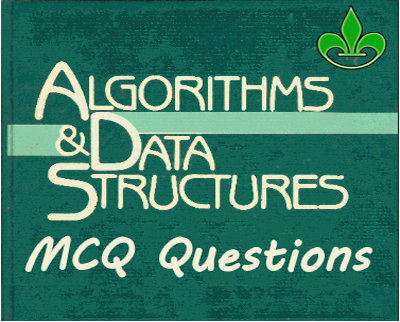Data Structures & Algorithms MCQ with Answers: This is continuation of previous post – Data Structures and Algorithms MCQ with Answers. The next set of 20 questions are presented in this post. As these are the most probable questions for any exam, hope these will be helpful.

You can find following multiple choice questions to test yourself for such expectation.
Data Structures And Algorithms MCQ Questions
Set 02
1. Each data item in a record may be a group item composed of sub-items; those items which are indecomposable are called
a. elementary items
b. atoms
c. scalars
d. all of above
2. Which of the following is two way list?
a. grounded header list
b. circular header list
c. linked list with header and trailer nodes
d. none of above
3. Which of the following statement is false?
a. Arrays are dense lists and static data structure
b. data elements in linked list need not be stored in adjacent space in memory
c. pointers store the next data element of a list
d. linked lists are collection of the nodes that contain information part and next pointer
4. When inorder traversing a tree resulted E A C K F H D B G; the preorder traversal would return
a. FAEKCDBHG
b. FAEKCDHGB
c. EAFKHDCBG
d. FEAKDCHBG
5. The memory address of the first element of an array is called
a. floor address
b. foundation address
c. first address
d. base address
6. The difference between linear array and a record is
a. An array is suitable for homogeneous data but the data items in a record may have different data type
b. In a record, there may not be a natural ordering in opposed to linear array.
c. A record form a hierarchical structure but a linear array does not
d. All of above
7. Which of the following name does not relate to stacks?
a. FIFO lists
b. LIFO list
c. Piles
d. Push-down lists
8. Which of the following data structures are indexed structures?
a. linear arrays
b. linked lists
c. both of above
d. none of above
9. The term “push” and “pop” is related to the
a. array
b. lists
c. stacks
d. all of above
10. The memory address of fifth element of an array can be calculated by the formula
a. LOC(Array[5]=Base(Array)+w(5-lower bound), where w is the number of words per memory cell for the array
b. LOC(Array[5])=Base(Array[5])+(5-lower bound), where w is the number of words per memory cell for the array
c. LOC(Array[5])=Base(Array[4])+(5-Upper bound), where w is the number of words per memory cell for the array
d. None of above
11. Two dimensional arrays are also called
a. tables arrays
b. matrix arrays
c. both of above
d. none of above
12. When new data are to be inserted into a data structure, but there is no available space; this situation is usually called
a. underflow
b. overflow
c. housefull
d. saturated
13. The situation when in a linked list START=NULL is
a. underflow
b. overflow
c. housefull
d. saturated
14. A variable P is called pointer if
a. P contains the address of an element in DATA.
b. P points to the address of first element in DATA
c. P can store only memory addresses
d. P contain the DATA and the address of DATA
15. Which of the following data structure can’t store the non-homogeneous data elements?
a. Arrays
b. Records
c. Pointers
d. None
16. Which of the following data structure store the homogeneous data elements?
a. Arrays
b. Records
c. Pointers
d. None
17. Which of the following is not a limitation of binary search algorithm?
a. must use a sorted array
b. requirement of sorted array is expensive when a lot of insertion and deletions are needed
c. there must be a mechanism to access middle element directly
d. binary search algorithm is not efficient when the data elements are more than 1000.
18. Binary search algorithm can not be applied to
a. sorted linked list
b. sorted binary trees
c. sorted linear array
d. pointer array
19. A data structure where elements can be added or removed at either end but not in the middle
a. Linked lists
b. Stacks
c. Queues
d. Deque
20. Which of the following is not the required condition for binary search algorithm?
a. The list must be sorted
b. there should be the direct access to the middle element in any sublist
c. There must be mechanism to delete and/or insert elements in list
d. none of above
Correct Answers to Data Structures And Algorithms MCQs
| 1- d | 2- d | 3- c | 4- b | 5- b | 6- d | 7- a | 8- a | 9- c | 10- a |
| 11- c | 12- b | 13- a | 14- a | 15- a | 16- a | 17- d | 18- a | 19- d | 20- c |
Mukesh Singh says
very nice sir,